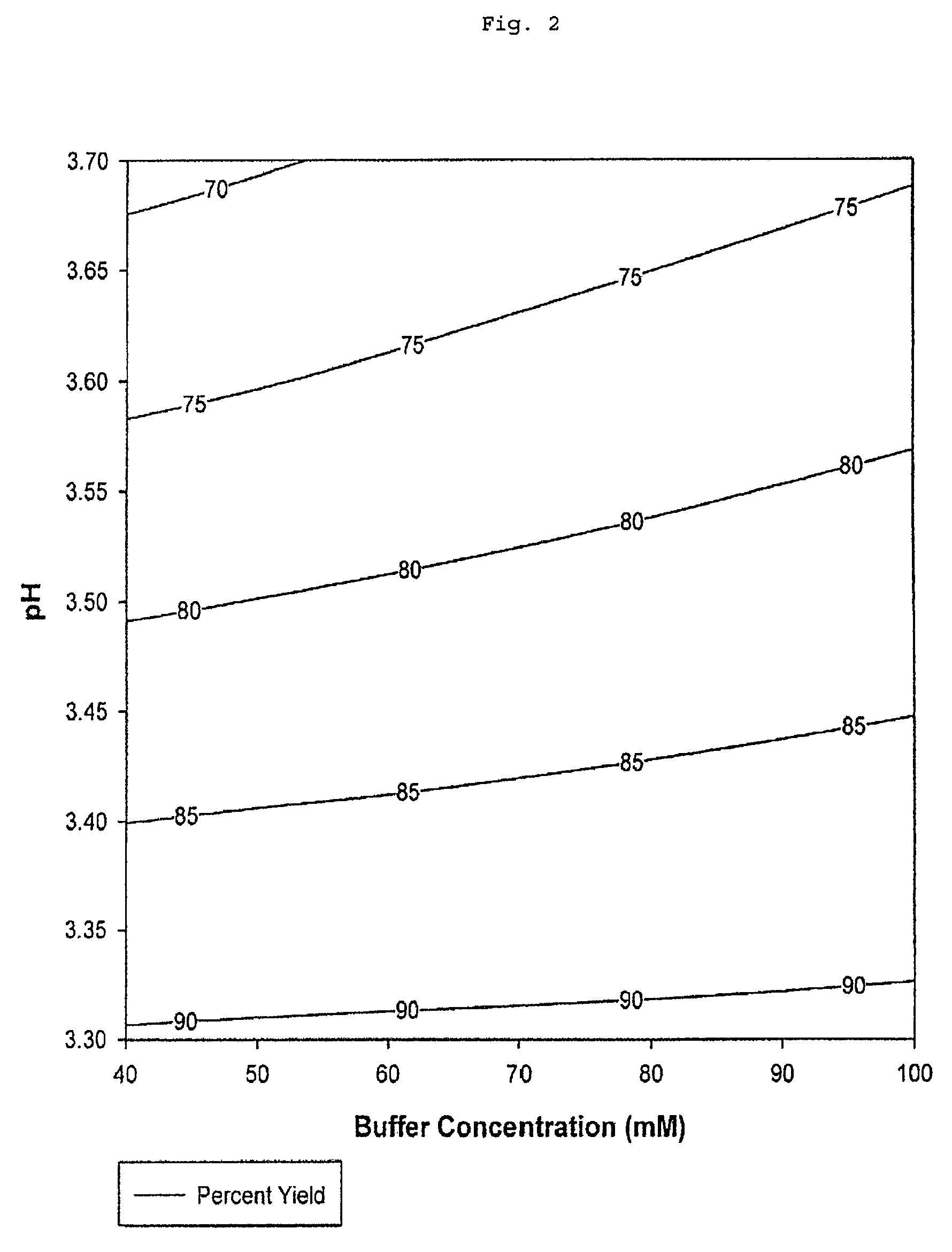Process for preparing unaggregated antibody Fc domains
a technology of unaggregated antibodies and domains, applied in the field of protein a chromatography, can solve the problems of life-threatening immune reactions of patients, formation of soluble high molecular weight aggregates containing multiple fc peptide chain molecules, and high undesirable presence of aggregates
- Summary
- Abstract
- Description
- Claims
- Application Information
AI Technical Summary
Benefits of technology
Problems solved by technology
Method used
Image
Examples
example 1
Protein A Chromatography Separation of Aggregated and Unaggregated Antibody Fc Domains
[0073]Protein A chromatography can be used to separate aggregated and unaggregated peptide chains comprising antibody Fc domains (Fc peptide chains) when specific elution conditions are used (Table 1).
[0074]
TABLE 1Results of Protein A Chromatography ExperimentProteinChroma-Concen-SampleTotalPercenttographictrationVolumeProteinAggregateSampleStep pH(mg / mL)(mL)(mg)(%)C1374C Cell—1.8112.8203.010.1CultureSupernatantSecond Wash5.00.00456.60.24—Elution3.65.429.1156.21.32Strip3.01.233.941.5841.9
90% of aggregated Fc peptide chains loaded onto a protein A chromatography column were separated from unaggregated Fc peptide chains when the column elution buffer comprised 50 mM sodium acetate at a pH of 3.6 (Table 1).
[0075]Protein A specifically binds antibody Fc domains when such domains are present and accessible in a peptide chain. Protein A chromatography under standard conditions yields a purified mixture o...
example 2
Total Percent Yield of Fc Peptide Chains after Protein a Chromatography is a Function of Elution Buffer Salt Concentration and pH
[0080]The total percent yield by mass of Fc peptide chains recovered after elution from the protein A chromatography column is a function of elution buffer tris(hydroxymethyl)aminomethane acetate salt concentration and pH (Table 2 and FIG. 2).
[0081]
TABLE 2Results of Protein A Chromatography ExperimentsElutionElutionBufferProteinPercentTotalElutionConcen-Concen-AggregatePercentBuffertrationtrationin ElutionYieldObjectivepH(mM)(mg / mL)(%)(%)Function3.7405.141.268.420.0003.71005.951.8674.50.3073.310018.009.1691.110.0003.34014.136.6590.340.0003.57010.502.9881.150.3873.48014.395.2989.490.0003.5609.762.0478.010.3963.56010.092.0980.610.4573.46011.573.6783.220.3423.6606.561.8375.160.330
Total percent yield values from the experimental data represents the percentage by mass of unaggregated Fc peptide chains and aggregated Fc peptide chains present in the purified sam...
example 3
Percent Aggregated Fc Peptide Chains in Protein a Chromatography Eluantes is a Function of Elution Buffer Salt Concentration and pH
[0089]The percentage of aggregated Fc peptide chains by mass in eluted samples recovered after protein A chromatography column purification is a function of elution buffer tris(hydroxymethyl)aminomethane acetate salt concentration and pH (Table 2 and FIG. 3). Percent aggregate values from the experimental data represent the percentage by mass of aggregated Fc peptide chain present in the purified sample recovered after elution relative to the total amount by mass of all Fc peptide chains, both aggregated and unaggregated, present in this sample. The percent aggregate value is a measure of the aggregated Fc peptide chain contamination level in the eluted sample recovered after protein A chromatography. Stated differently, percent aggregate is a measure of the purity of the eluted sample recovered.
[0090]Eluted samples were those produced by the protein A c...
PUM
| Property | Measurement | Unit |
|---|---|---|
| pH | aaaaa | aaaaa |
| height | aaaaa | aaaaa |
| pH | aaaaa | aaaaa |
Abstract
Description
Claims
Application Information
 Login to View More
Login to View More - R&D
- Intellectual Property
- Life Sciences
- Materials
- Tech Scout
- Unparalleled Data Quality
- Higher Quality Content
- 60% Fewer Hallucinations
Browse by: Latest US Patents, China's latest patents, Technical Efficacy Thesaurus, Application Domain, Technology Topic, Popular Technical Reports.
© 2025 PatSnap. All rights reserved.Legal|Privacy policy|Modern Slavery Act Transparency Statement|Sitemap|About US| Contact US: help@patsnap.com



